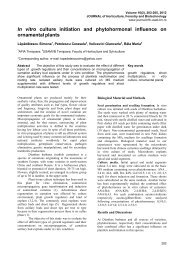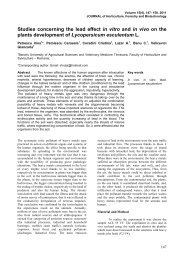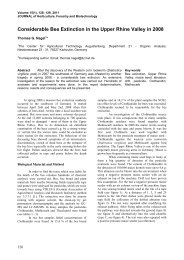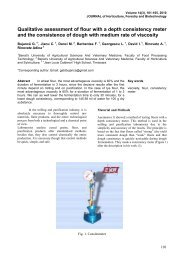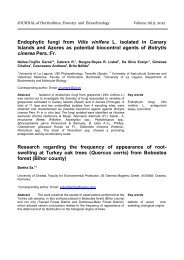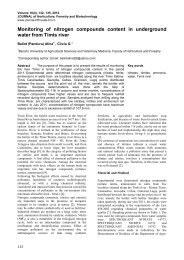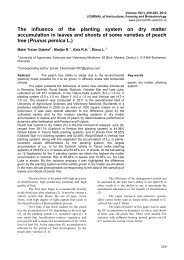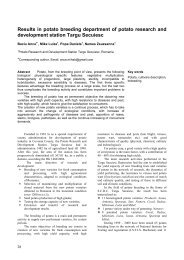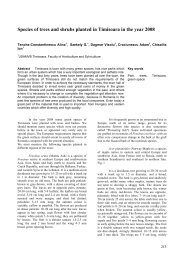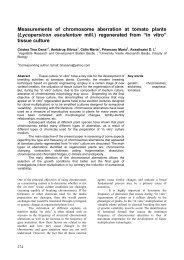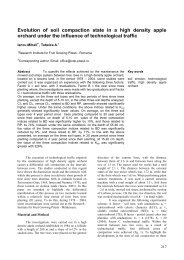Comparative study on the in vitro multiplication potential of Magnolia ...
Comparative study on the in vitro multiplication potential of Magnolia ...
Comparative study on the in vitro multiplication potential of Magnolia ...
Create successful ePaper yourself
Turn your PDF publications into a flip-book with our unique Google optimized e-Paper software.
“FACULTATEA DE HORTICULTURĂ ŞI SILVICULTURĂ”Rooted plantlets had been acclimatized <strong>in</strong> <strong>the</strong> greenhouse and transferr<strong>in</strong>g to <strong>the</strong> soil substrate (fig. 8).Fig. 8. <strong>Magnolia</strong> plants after transfer from greenhouse c<strong>on</strong>diti<strong>on</strong>s to soilC<strong>on</strong>clusi<strong>on</strong>s1. The results presented <strong>in</strong> this paper <strong>in</strong>dicatethat <strong>the</strong> percentage <strong>of</strong> regenerat<strong>in</strong>g, shoot number perexplant, percentage <strong>of</strong> root<strong>in</strong>g were affected bygenotype and <strong>the</strong> <strong>in</strong>teracti<strong>on</strong> <strong>of</strong> genotype with <strong>the</strong>culture media. Between <strong>Magnolia</strong> stellata and<strong>Magnolia</strong> x soulangiana species tested, <strong>the</strong> best resultsas well as percent <strong>of</strong> regenerati<strong>on</strong>, number <strong>of</strong> shootsper explant and root<strong>in</strong>g rate were recorded for<strong>Magnolia</strong> stellata species.2. Explants <strong>of</strong> apical buds represent optimalsource <strong>of</strong> <strong>in</strong>oculums. The period most <strong>in</strong>dicated forsampl<strong>in</strong>g and <strong>in</strong>oculat<strong>in</strong>g explants is November-December when vegetative buds are <strong>in</strong> <strong>the</strong> dormantstage.3. Research <strong>in</strong> <strong>the</strong> evaluati<strong>on</strong> <strong>of</strong>morphogenetic capacity <strong>of</strong> explants <strong>on</strong> differentnutrient regenerati<strong>on</strong> formulas and results obta<strong>in</strong>edhave shown that <strong>the</strong> best results <strong>in</strong> terms <strong>of</strong> percentage<strong>of</strong> explants started <strong>the</strong> trend was obta<strong>in</strong>ed <strong>on</strong> <strong>the</strong>versi<strong>on</strong> supplemented with 0.7 mg/l BAP, 1 mg/lNAA, 0.1 mg/l GA 3 , 5 mg/l ascorbic acid and vitam<strong>in</strong>sLS.4. Our results dem<strong>on</strong>strate <strong>the</strong> clearly<strong>in</strong>fluence <strong>of</strong> citok<strong>in</strong><strong>in</strong>e type <strong>on</strong> <strong>the</strong> regenerati<strong>on</strong> rate.The best shoot multiplicati<strong>on</strong> rate (10.7microshoots/explant <strong>in</strong> <strong>the</strong> case <strong>of</strong> <strong>Magnolia</strong> stellataspecies and 10 microshoots/explant at <strong>Magnolia</strong> xsoulangiana) was established with Murashige-Skoogm<strong>in</strong>eral salts, Miller vitam<strong>in</strong>s and 0,5 mg/l BAP.5. It took <strong>on</strong>ly 17 days for root <strong>in</strong>itiati<strong>on</strong> <strong>of</strong>magnolia shoots. The best c<strong>on</strong>centrati<strong>on</strong> <strong>of</strong>supplemented IBA for root <strong>in</strong>itiati<strong>on</strong> was 4 mg/l.6. The results obta<strong>in</strong>ed <strong>in</strong> our <strong>in</strong>vestigati<strong>on</strong>sproved that <strong>in</strong> <strong>vitro</strong> culture could be used as anefficient alternative method for multiplicati<strong>on</strong> <strong>of</strong><strong>Magnolia</strong> stellata and <strong>Magnolia</strong> x soulangiana species.Bibliography1. Biederman I. E. G. - 1987 - Factors affect<strong>in</strong>gestablishment and development <strong>of</strong> <strong>Magnolia</strong> hybrids <strong>in</strong><strong>vitro</strong>, Acta Horticulturae, 212, s. 625-629.2. Callaway D.J. – 1994 - The world <strong>of</strong> <strong>Magnolia</strong>s,Timber Press, Portland, 260 pp.3. Kamenicka Aurelia, Lanakova Maria – 2000 -Effect <strong>of</strong> medium compositi<strong>on</strong> and type <strong>of</strong> vesselclosure <strong>on</strong> axillary shoot producti<strong>on</strong> <strong>of</strong> magnolia <strong>in</strong><strong>vitro</strong>, Acta Physiologiae Plantarum, vol: 22, number: 2,pages: 129-134.4. Kamenicka Aurelia, Takats J. – 1997 - <strong>Magnolia</strong>, 1:1-6.5. Liu Y.H. – 2004 - <strong>Magnolia</strong> <strong>of</strong> Ch<strong>in</strong>a. Beij<strong>in</strong>gScience&Technology Press, 391 pp.6. Merkle S.A. - 1995 - Somatic embryogenesis <strong>in</strong><strong>Magnolia</strong>ceae (Liliodendr<strong>on</strong> and <strong>Magnolia</strong>s). In: BajajY.P.S. (ed.) Somatic embryogenesis and Syn<strong>the</strong>ticSeed I. Spr<strong>in</strong>ger-Verlag, Berl<strong>in</strong>, Heidelberg: 388-403.7. Merkle S.A., Wats<strong>on</strong>-Pauley B.A. – 1994 - Ex <strong>vitro</strong>c<strong>on</strong>versi<strong>on</strong> <strong>of</strong> pyramid magnolia somatic embryos,HortScience, v. 29(10) p. 1186-1188.8. Tobe J.D. – 1990 - Journal <strong>of</strong> <strong>Magnolia</strong> Soc., 26 : 4844



